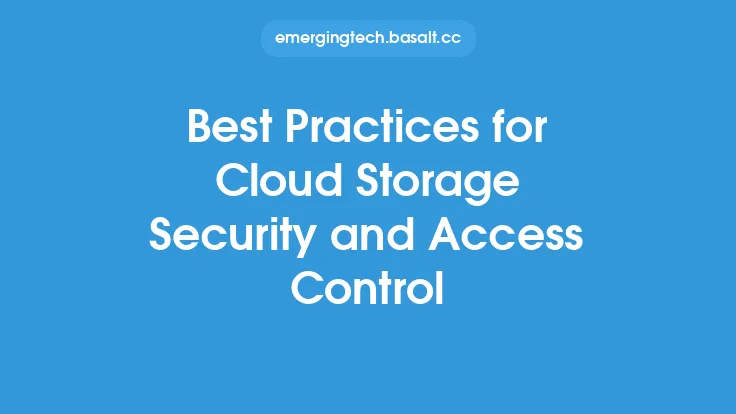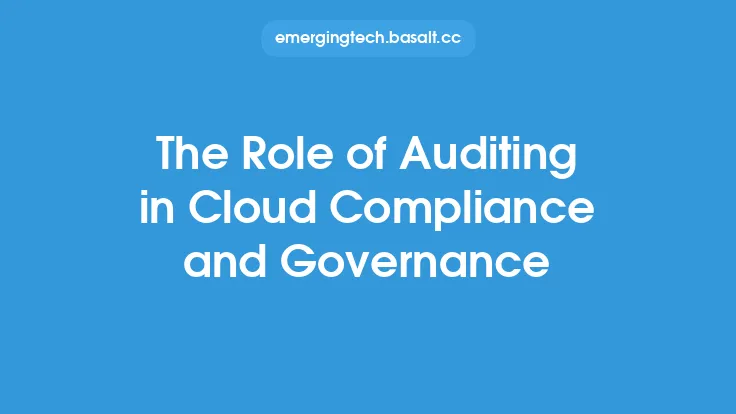In today's digital landscape, cybersecurity governance and compliance are crucial components of any organization's overall security posture. As technology continues to evolve and become more integrated into business operations, the risk of cyber threats and data breaches also increases. Effective cybersecurity governance and compliance practices are essential to mitigate these risks and ensure the confidentiality, integrity, and availability of sensitive data. In this article, we will delve into the best practices for cybersecurity governance and compliance, providing a comprehensive overview of the key principles, frameworks, and technologies that organizations can leverage to strengthen their security controls.
Introduction to Cybersecurity Governance
Cybersecurity governance refers to the set of policies, procedures, and standards that an organization implements to manage and mitigate cyber risks. It involves the establishment of a clear governance structure, which includes defined roles and responsibilities, to ensure that cybersecurity is integrated into the organization's overall risk management framework. Effective cybersecurity governance is critical to ensuring that an organization's security controls are aligned with its business objectives and that it is compliant with relevant laws, regulations, and industry standards. A well-defined governance structure should include a clear incident response plan, a disaster recovery plan, and a business continuity plan to ensure that the organization can respond quickly and effectively in the event of a security incident.
Compliance Frameworks and Standards
Compliance frameworks and standards play a critical role in ensuring that an organization's cybersecurity controls are aligned with industry best practices and regulatory requirements. Some of the most widely adopted compliance frameworks and standards include the National Institute of Standards and Technology (NIST) Cybersecurity Framework, the Payment Card Industry Data Security Standard (PCI DSS), and the International Organization for Standardization (ISO) 27001. These frameworks and standards provide a set of guidelines and requirements that organizations can follow to implement effective security controls and ensure compliance with relevant laws and regulations. For example, the NIST Cybersecurity Framework provides a comprehensive framework for managing and reducing cyber risk, while the PCI DSS provides a set of requirements for protecting sensitive payment card information.
Risk Management and Assessment
Risk management and assessment are critical components of any cybersecurity governance and compliance program. Risk management involves the identification, assessment, and mitigation of potential cyber risks, while risk assessment involves the evaluation of the likelihood and potential impact of a security incident. Organizations should conduct regular risk assessments to identify potential vulnerabilities and threats, and implement controls to mitigate these risks. This can include implementing security controls such as firewalls, intrusion detection systems, and encryption, as well as providing employee training and awareness programs to prevent social engineering attacks. Additionally, organizations should implement a risk management framework that includes a clear risk assessment methodology, a risk mitigation strategy, and a continuous monitoring program to ensure that security controls are effective and up-to-date.
Incident Response and Management
Incident response and management are critical components of any cybersecurity governance and compliance program. Incident response involves the detection, response, and containment of security incidents, while incident management involves the coordination and management of incident response activities. Organizations should have a clear incident response plan in place, which includes defined roles and responsibilities, incident classification and prioritization procedures, and communication protocols. The incident response plan should also include procedures for containing and eradicating security incidents, as well as procedures for post-incident activities such as lessons learned and continuous improvement. Additionally, organizations should conduct regular incident response training and exercises to ensure that employees are prepared to respond quickly and effectively in the event of a security incident.
Security Controls and Technologies
Security controls and technologies are essential components of any cybersecurity governance and compliance program. Security controls include policies, procedures, and standards that are implemented to manage and mitigate cyber risks, while security technologies include hardware and software solutions that are used to implement security controls. Some common security controls and technologies include firewalls, intrusion detection systems, encryption, access control systems, and security information and event management (SIEM) systems. Organizations should implement a layered security approach, which includes multiple security controls and technologies to provide defense-in-depth protection against cyber threats. Additionally, organizations should regularly review and update their security controls and technologies to ensure that they are effective and up-to-date.
Continuous Monitoring and Improvement
Continuous monitoring and improvement are critical components of any cybersecurity governance and compliance program. Continuous monitoring involves the ongoing evaluation and assessment of security controls and technologies to ensure that they are effective and up-to-date. Improvement involves the identification and implementation of opportunities for improvement, such as updating security controls and technologies, providing employee training and awareness programs, and conducting regular risk assessments and incident response exercises. Organizations should implement a continuous monitoring program that includes regular security assessments, vulnerability scanning, and penetration testing to identify potential vulnerabilities and threats. Additionally, organizations should establish a culture of continuous improvement, which includes encouraging employee feedback and suggestions, and providing regular training and awareness programs to ensure that employees are aware of the latest cyber threats and security best practices.
Conclusion
In conclusion, cybersecurity governance and compliance are critical components of any organization's overall security posture. Effective cybersecurity governance and compliance practices are essential to mitigate cyber risks and ensure the confidentiality, integrity, and availability of sensitive data. By implementing best practices such as establishing a clear governance structure, adopting compliance frameworks and standards, conducting regular risk assessments, implementing incident response and management plans, and leveraging security controls and technologies, organizations can strengthen their security controls and ensure compliance with relevant laws and regulations. Additionally, by implementing continuous monitoring and improvement programs, organizations can ensure that their security controls are effective and up-to-date, and that they are prepared to respond quickly and effectively in the event of a security incident.





